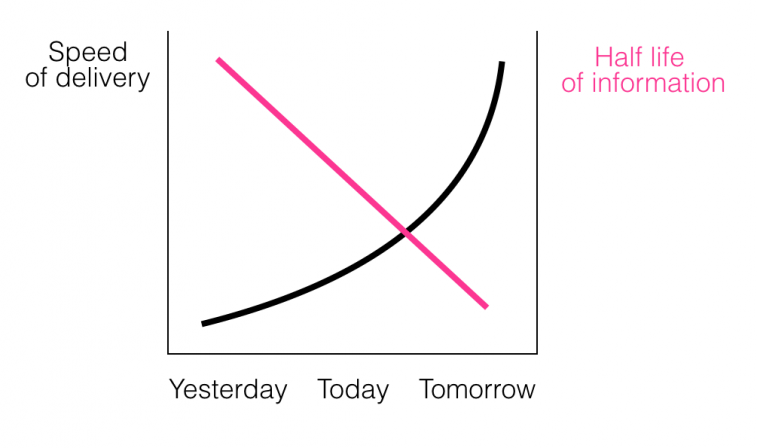To the extent, these days, time is being counted in nano-seconds and everything is happening in real-time, there is an evermore acute merit to being “ahead of the curve.” One can safely say that notion of being ahead of the curve has always been true. However, there has been a certain acceleration of time. As a result, staying ahead of the game has been become significantly harder. Just ask a journalist: how do you stay ahead of unpaid bloggers and Twitter accounts?
The relevance of this question is that there are competing forces at hand:

As soon as one publishes content online, its half-life — i.e. its legacy visibility — declines rapidly.
[tweetthis display_mode=”box”]The half life of online content is decreasing on pace with the withering attention span.[/tweetthis]
Whether this is because of the Facebookian algorithms or just the nature of infobesity that overwhelms the regular netizen, content typically needs to be picked up and shared in the very first few moments of posting to be a candidate for virality.
There is increasing pressure on the speed of covering the “news.” And yet, the half life of the news, in terms of how long it stays on the airwaves, is constantly on the decrease.
The difference between news and content
In order to compensate for this manic race against time, there are now many tools that help manage one’s curation and distribution of news and interesting content. Taking the media company mentality that is espoused by the more forward-thinking brands (e.g. Red Bull), the challenge then becomes keeping ahead of the news all the while serving one’s audience with timely information on a regular and consistent basis. Put another way, the fundamental question I pose for posting news is:
Should one publish the news when one hears it or when one’s audience is on line?
The digital tortoise versus the hare

With the opportunity to schedule posts in advance, one can provide interesting content on a regular basis that appears in the streams of one’s followers. However, that content or news is, by definition, delayed from the time you (as the publisher) came across it. By pre-programming your posts, you are operating more like the digital tortoise. If you post as it comes out, you’re more like the digital hare.
For brands, it’s already quite the challenge to be aware of all the best news (that is important and relevant). It is another to be able to publish it at the best times for one’s public.
Is it better then to be fast and ahead of the curve, ie. the digital hare, even if that means your own audience will not see it? Or should you rather deliver and distribute the news — at the risk of being late — when your readership is ready to receive? In other words: the digital tortoise. Personally, to the extent I am not a news entity myself, the digital tortoise approach suits me well.
Your thoughts and interrogations?











